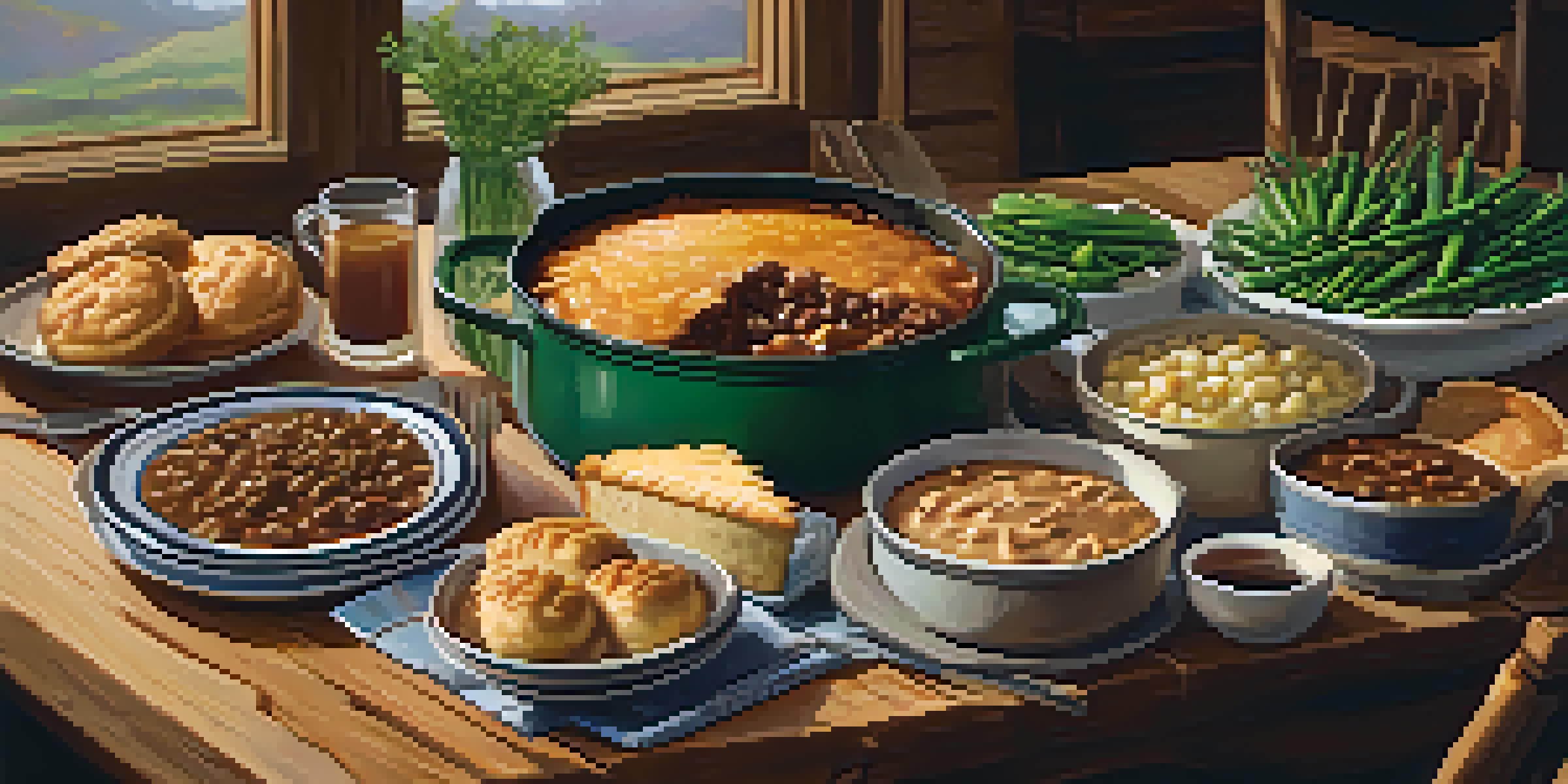Midwest Comfort Food: Exploring Culinary Traditions

The Heart of the Midwest: Understanding Comfort Food
Midwest comfort food is more than just a meal; it's a warm embrace on a plate. These dishes often reflect the region's agricultural roots, showcasing local ingredients that nourish both body and soul. Think of hearty casseroles, savory pies, and rich stews that remind you of home-cooked meals shared with family.
Food is our common ground, a universal experience.
For many in the Midwest, comfort food evokes nostalgia, taking us back to cherished moments around the dinner table. Whether it's grandma's famous pot roast or a neighbor's homemade apple pie, these recipes are woven into the fabric of our lives. They tell stories of tradition, love, and community.
In essence, Midwest comfort food is about simplicity and heartiness. It celebrates the idea that food should be satisfying and fulfilling, providing not just nourishment but also joy. As we explore these culinary traditions, we’ll uncover the flavors that define the Midwest.
Classic Dishes: A Taste of Tradition
No exploration of Midwest comfort food would be complete without mentioning classic dishes like chicken and dumplings or beef stew. These meals are often prepared in large batches, making them perfect for gatherings or family dinners. Each bite is a reminder of the love and care that goes into home cooking.

Another favorite is the infamous casserole, which can be found at nearly every potluck. These one-dish wonders, like tater tot hotdish or green bean casserole, are easy to prepare and always a crowd-pleaser. They exemplify the Midwest's practical approach to cooking, combining flavors and ingredients into satisfying meals.
Midwest Comfort Food: A Warm Embrace
These hearty dishes reflect the region's agricultural roots and evoke cherished memories of family and community.
Finally, let’s not forget about the sweet side of comfort food. Desserts like cherry pie or chocolate chip cookies are staples that bring smiles and warmth to any gathering. They remind us that, in the Midwest, food is not just about sustenance—it's about creating joyful memories.
Seasonal Favorites: Cooking with the Seasons
Midwest cooking is deeply connected to the changing seasons. In spring, you might enjoy dishes featuring fresh asparagus or rhubarb, while summer brings an abundance of sweet corn and tomatoes. These seasonal ingredients not only enhance flavor but also foster a sense of connection to the land.
Cooking is like love; it should be entered into with abandon or not at all.
As autumn rolls around, hearty dishes like pumpkin soup and apple crisp come into focus. These meals celebrate the harvest and are often enjoyed during family gatherings or fall festivals. They provide warmth and comfort during the cooler months, making them essential to the Midwest experience.
Winter, on the other hand, calls for rich and warming foods, such as creamy chowders or slow-cooked roasts. These meals are designed to sustain us through the cold, bringing families together around the table. The cyclical nature of cooking with the seasons is a testament to the Midwest's culinary traditions.
Farm-to-Table: Celebrating Local Ingredients
The farm-to-table movement has found a stronghold in the Midwest, where local produce and meats are celebrated. This approach not only supports local farmers but also ensures that meals are fresh and flavorful. As a result, many Midwest restaurants emphasize seasonal menus that highlight regional ingredients.
For example, you'll find dishes featuring grass-fed beef from local ranches or heirloom tomatoes from nearby farms. This connection to the land enriches the dining experience, allowing people to savor the true essence of Midwest flavors. It's about appreciating the hard work that goes into growing and producing food.
Seasonal Cooking Connects Us to Nature
Midwest cooking emphasizes seasonal ingredients, fostering a deeper connection to the land and its bounties.
Ultimately, farm-to-table dining embodies the spirit of Midwest comfort food by fostering community connections. It encourages us to support local economies while enjoying the best that the region has to offer. This practice enhances our meals, making them more than just food—it's a celebration of our shared heritage.
Regional Variations: A Taste of Diversity
While Midwest comfort food is often characterized by certain staples, it's also home to diverse regional variations. For instance, you'll find different takes on chili across states, with some adding beans while others prefer a meatier version. These local tweaks reflect the unique cultural influences present in each area.
In cities like Chicago, deep-dish pizza has become a culinary icon, while in St. Louis, toasted ravioli reigns supreme. Each dish tells a story about the community and its culinary heritage. Exploring these regional specialties adds richness to our understanding of Midwest comfort food.
This diversity showcases the Midwest as a melting pot of flavors and traditions. It encourages us to celebrate what makes each area unique while recognizing the common threads that connect us all through food. Midwest comfort food is truly a reflection of its people and their stories.
Modern Twists: Reinventing Comfort Food
As we move further into the 21st century, Midwest comfort food is undergoing a transformation. Chefs are taking traditional recipes and giving them modern twists, incorporating global flavors and contemporary techniques. This evolution keeps comfort food exciting and relevant for new generations.
For instance, you might find spicy kimchi added to classic dishes, or gourmet versions of mac and cheese featuring truffle oil. These innovations highlight creativity while still honoring the roots of comfort food. It’s a delicious way to bridge the past and the present.
Community Building Through Shared Meals
Comfort food plays a vital role in bringing people together, creating bonds and celebrating shared values in the Midwest.
This modern approach doesn’t replace traditional meals; instead, it enriches the culinary landscape. It encourages us to explore and experiment with flavors while still finding comfort in familiar dishes. The result is a vibrant mix of old and new that continues to define the Midwest.
The Role of Comfort Food in Community Building
Comfort food plays a vital role in building and nurturing community connections. Whether it’s a potluck event, a family gathering, or a neighborhood barbecue, these meals bring people together. Sharing food fosters bonds, encourages conversation, and creates lasting memories.
In many Midwest towns, community events often feature beloved comfort food, showcasing local recipes passed down through generations. These gatherings create a sense of belonging, reminding us that we are part of something bigger than ourselves. Food becomes a vehicle for connection and celebration.

Ultimately, comfort food is a reflection of the Midwest's values—hard work, hospitality, and togetherness. It reminds us that, regardless of our differences, we can come together around a table and share in the joy of good food. That’s the true essence of Midwest comfort food.